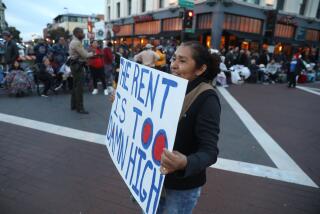U.S. Economy Inefficiency, Inequity a Burden on Poor
- Share via
One of the classic trade-offs in economics is between equity and efficiency. Under many circumstances, arrangements or policies that enhance one of these goals do so by sacrificing some of the other. Since the early 1970s, the U.S. economy has managed to do poorly on both counts.
Not only has aggregate or median real income grown slowly--a result of poor efficiency or productivity growth--but the distribution of income has become substantially more unequal over this period--a measure of reduced equity in the society.
The slowdown in aggregate real growth in the U.S. economy has been widely noted for years. The fact that it has been accompanied by growing inequality has only recently been getting comparable attention.
The extremes of poverty and homelessness are visible throughout the nation. But the growing inequality is much broader than these obvious extremes and extends throughout the population.
In recent testimony before the Senate Budget Committee, Gary Burtless of the Brookings Institution, who has been at the forefront of research in this area, put these developments into perspective. From 1947 through 1973, the median income of American families rose, on average, nearly 2.8% a year.
Between 1973 and 1989, the last year for which full data is available, median family income rose by less than 0.5% a year. In the period of good overall growth, 1947-1973, families at all income levels prospered. What small differences there were in income growth favored those in the center of the income distribution, with the slowest growth in incomes occurring in the top 5% income group.
In sharp contrast, since 1973 income growth has been inversely related to family income levels. At the extreme, families in the bottom fifth of the income distribution had no growth of real income at all, while families in the top 5% averaged nearly 1.5% annual income growth.
The disparities are even more glaring over just the past decade. From 1979 to 1989, real income declined for families in the bottom fifth of the income distribution and rose nearly 12% for families in the top fifth. Families in the top 5% of the distribution did best of all, enjoying average gains in real incomes of over 17%.
These changes have reversed the trend toward slightly more equality that had characterized the earlier postwar years. The ratio between the average family income for the top 5% and for the bottom 20% declined from about 11 to 1 in 1947 to 9.5 to 1 in the late 1960s. By 1989, it was back up to 15.5 to 1.
Because the income distribution is cyclical, the ratio has no doubt risen substantially further with the 1990-91 recession. But even before this recession, family income inequality had reached a new postwar high. And although family income is not the only way to measure relative well-being, no reasonable alternative measure would challenge the fact that, on average, those who started the 1980s poor ended them even poorer, while those who began the decade affluent ended it more affluent than ever.
The government’s tax and transfer policies affect the distribution of income. In the 1980s, income and payroll tax changes and a reduction in federal transfer payments to low-income families added to income inequality. Taxes and transfers, particularly those aimed at single-parent households, could now be adjusted to help redress the balance and ameliorate hardships of the least well-off.
However, underlying economic developments have been even more important than policy changes. Burtless shows that a principal reason for the growing inequality of family incomes is the growing inequality of wages among adult male workers. From 1979 to 1987, the last year for which data is available, real wages of male workers aged 25 to 64 declined by an average of 2% a year for those in the bottom fifth of the wage distribution, while they rose by 0.5% a year for those in the top fifth of the distribution.
Even that does not tell the whole story. Not only have their wages declined, but the poorest workers have found it increasingly difficult to find jobs at all. Changes in the U.S. economy have not produced a surplus of bad jobs, as is commonly asserted, but a surplus of less-skilled workers in a market requiring more skill than ever.
Burtless concludes that it is crucial to improve the educational system so that it provides emerging workers with appropriate work skills. When common sense and careful analysis coincide, it must be right.
More to Read
Inside the business of entertainment
The Wide Shot brings you news, analysis and insights on everything from streaming wars to production — and what it all means for the future.
You may occasionally receive promotional content from the Los Angeles Times.










